If you go into the backcountry enough, eventually, you’re going to end up camping in a thunderstorm or similar severe weather event. While this is more likely to happen in some parts of the country than others, camping during a thunderstorm or other adverse weather conditions is something that every serious outdoors enthusiast needs to prepare for. A tent in lightning is terrifying, after all!
Don’t let the risk of severe weather ruin a trip or keep you from heading into the wilderness. If you’re stuck camping in a thunderstorm, you’ll need to take some basic precautions. By ensuring you have the right gear ahead of time, you’re ready when the weather gets nasty, and you’ll know what steps to take so you can keep yourself and the rest of your party safe.
Three Things to Keep in Mind When Camping in a Thunderstorm
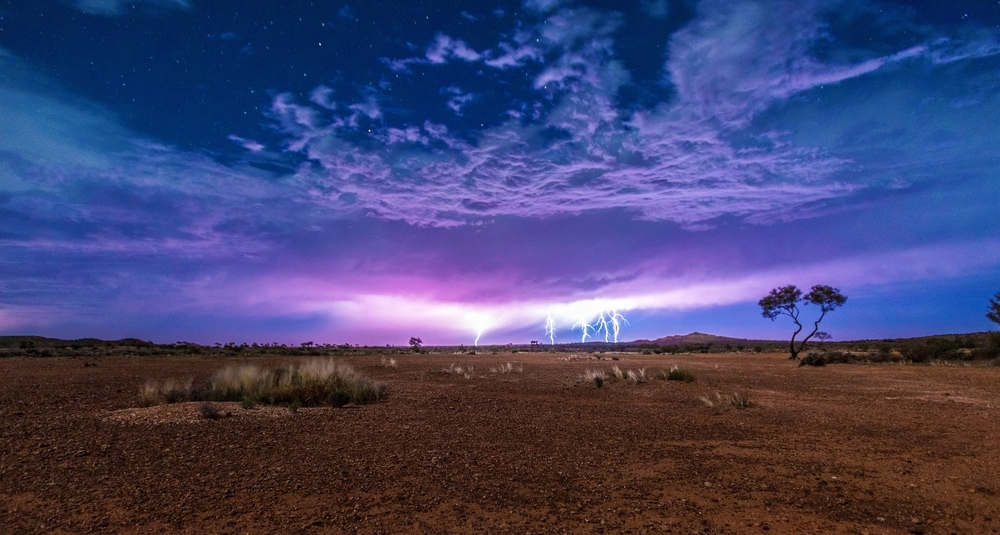
Before we get to our list of ten tips for camping in a thunderstorm, we thought it would be a good idea to talk about three important ideas beforehand. These should be taken separately from our list because it’s one thing to research safety tips and gear recommendations online. Still, it’s another thing entirely when you’re dealing with scenarios like these in real life.
If you keep these three things in mind, you’ll be prepared to face the risks associated with camping in a thunderstorm.
1. The Biggest Threat to Your Safety Is Exposure
If you’re out enjoying this country’s natural spaces and there’s a thunderstorm approaching, it’s important not to panic. The lightning certainly is dangerous, but it’s not the factor you need to be the most concerned about. The biggest threat to individuals or groups camping in a thunderstorm is exposure to cold from the rain, wind, and the elements.
In certain parts of the U.S., thunderstorms can be seasonally severe and come with other severe weather phenomena like hail or tornadoes. When you’re thinking about protecting yourself from exposure in the wild, severe weather or not, remember the biggest precautions you can take beforehand are keeping an eye on the weather at all times and preparing for the terrain.
Individuals who are killed due to severe weather while camping most often die from exposure to the cold. Inevitably, this type of disaster also means rain, wind, and the possibility of flooding or flash flooding. While lightning can be dangerous, it’s the other severe weather that comes with it that poses the biggest threat.
👉🏽 To Prevent Exposure, Preparation Is Key
When preparing for severe weather in the backcountry, get into the habit of visually monitoring the weather at all times, even when the weather is calm and the skies are clear. Besides visual monitoring, it’s a good idea to go online and check the weather forecast for the entire duration of your trip.
If you’re traveling further away from home, it’s a good idea to make a note of what county you’ll be in so that you can be aware of any severe weather watches. If you’re camping during severe weather season, you may want to consider getting a battery-operated NOAA radio like this one.
- Clear and long range reception
- Handheld portable radio
- Easy to use
If you’re lucky enough to have cell reception, make sure you’ve enabled severe weather alerts on your phone. Finally, remember that regardless of what part of the country you’re in, thunderstorms overwhelmingly happen from late afternoon to evening, although they can happen earlier or later.
2. Your Tent Provides No Protection From Lightning
If you’re in a scenario where you’re camping during a thunderstorm, it’s important to remember that contrary to what you might think, your tent is not your friend, and you should take safe shelter in your tent only if you have no other options. If you’re camping during a thunderstorm, it’s important to understand the nature of the threat that lightning poses fully.
This is something we’ll deal with more later on, but if you’re stuck in your tent during a thunderstorm because you have no option for shelter, then staying safe is more a matter of what you shouldn’t do rather than what you should. The most important thing to remember when you’re camping in a thunderstorm is that your tent will offer no real protection from lightning.
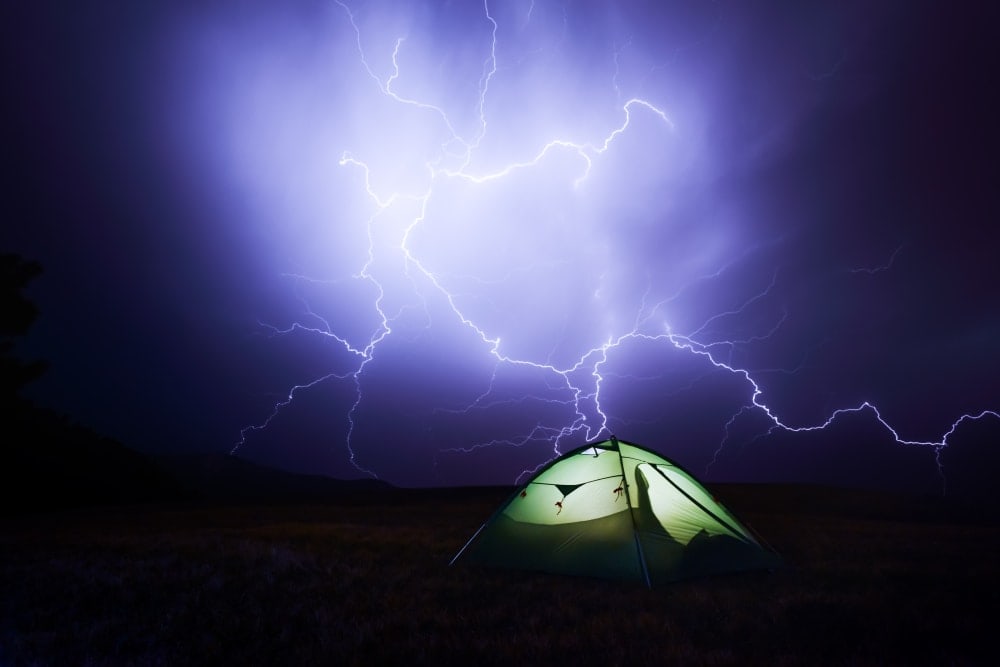
3. You Don’t Have to Get Struck by Lightning to Get Hurt by Lightning
Any guide that talks about staying safe in a thunderstorm will tell you that Incidents where lightning strikes human beings are rare. Statistically speaking, the CDC estimates that you have a roughly 1:15,300 chance of being struck by lightning. Now, statistics like this are accurate but taken out of context; they can be misleading.
Studies of lightning strikes overwhelmingly favor populated areas, so they don’t tell the entire story. The fact is, if you’re in a remote or unpopulated area, you’re at an increased risk of being struck by lightning relative to the rest of the population because there are no buildings to shelter in.
What further complicates things is that even though you’re at an increased risk of being struck by lightning when you’re in the backcountry, you have far fewer options to protect yourself from it.
The other point to keep in mind is that you don’t have to be struck by lightning to be injured by it. Simply being outdoors near a lightning strike is enough to put you at serious risk of permanent injury or even death.
👉🏽 With Lightning Strikes, Death Is Rare, but Serious Injuries Are Frequent
Lighting strikes only result in death about 10% of the time. But survivors of lighting strikes often suffer permanent injuries and lasting side effects. The most common long-term side effects are brain damage, neurological issues, cardiac issues, spinal weakness, muscle weakness, and difficulty focusing or concentrating for long periods.
This is why it’s vital to know how to stay safe in a thunderstorm when you’re camping.
👉🏽 When Camping in a Thunderstorm, Pay Close Attention to the Terrain
If you think you might end up camping in a thunderstorm, it pays to think hard about where and how you situate your campsite. Out of all the different terrain types, thunderstorms in mountainous regions are the most dangerous because you’re going to be higher up. Likewise, desert terrain with box canyons and slot canyons can also be quite dangerous.
If you’re camping and trying to situate your campsite with protection from severe weather in your mind, it’s a good idea to avoid the following types of spaces:

- Open Areas: Try not to position your campsite in a spot where you are the tallest object around. In this scenario, you’re vulnerable to a direct strike.
- Near Isolated Trees: You don’t want to be near isolated trees or isolated stands in open meadows; since these are tall, isolated objects, you’re vulnerable to side flashes.
- Open Buildings: Avoid open buildings such as hiking shelters or patio covers like you might see in some campgrounds; these also leave you vulnerable to side flashes.
- Caves: Unless the cave is deep enough that you can’t see the entrance, a cave does not protect from lightning.
- The TimberLine: Mountainous areas are always going to be dangerous when it comes to lighting strikes, especially if you’re near or above the timberline.
- Bodies Of Water: Avoid ponds, lakes, and rivers.
- High Or Exposed Terrain: For mountainous areas, avoid peaks, sheer cliffs, ledges, or ridgelines.
For a more in-depth guide that talks about how lighting strikes can interact with different landscape features to injure hikers and campers, check out this article from the National Weather Service.
👉🏽 Staying Safe While Camping in Lightning
If a thunderstorm moves into the area you’re camping in, your best bet is to seek shelter in a developed building that has plumbing or electricity.
If there isn’t a developed building nearby, your next safest option is your car. If you shelter in your car during a thunderstorm, remember not to touch the door handles or the windshield, as these are not attached to the metal frame of the car, so they cannot conduct electricity.
👉🏽 Just Because You Can’t See Lightning Doesn’t Mean You’re Safe
Finally, don’t think you’re off the hook if there’s thunder but no lightning. If you’re in the wild and the weather deteriorates, seek shelter immediately. If there’s thunder in your immediate area, that means there’s a risk of lightning in your immediate area.
👉🏽 Sheltering in Your Tent During a Thunderstorm
If you have no other options, you’re going to need shelter from the wind and the rain. It is possible to get hypothermia year-round in a wide variety of climates. This is especially true of mountainous areas in the springtime, where rain can be quite heavy without turning to snow.
If you shelter in your tent during a thunderstorm, try insulating yourself from the ground using a tarp or your sleeping bag. If lightning strikes the ground nearby, the extra layers will provide some insulation from the current. Remember not to touch the sides of your tent, and avoid touching the tent poles or the zippers.
If you’re sheltering in your tent during a thunderstorm, position yourself in the center of your tent and make yourself small by hugging your knees to your chest. The goal here is to take up as little space as possible while making as little contact with the ground as possible.
Ten Ways to Be Safe During Camping in Thunderstorm
Dealing with a thunderstorm when you’re in the wilderness is very different from dealing with a thunderstorm in a populated area. If you’re unprepared, you risk permanent injury or even death. We’ve put together this list of safety tips for camping in a thunderstorm because we want our readers to stay safe while enjoying this country’s wild spaces.
Remember as you read this list that these suggestions don’t cover everything you can do to ensure your safety while camping in a thunderstorm. As you read this list, think hard about how each of these tips applies to your situation or a trip you’re planning to take with friends and family. All of these tips will help keep you aware, focused, and prepared in the wild.
1. Choose the Right Campsite
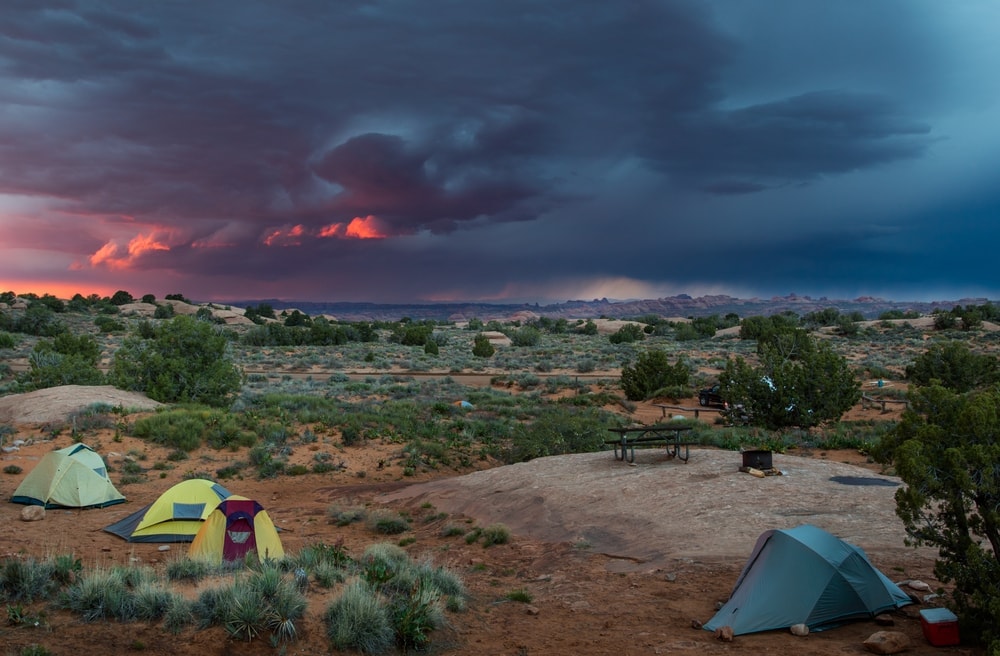
Suppose you’re worried about camping in a thunderstorm. In that case, the most significant step you can take to protect your tent from lightning and the other elements is to pick a suitable campsite beforehand. Pick a level, dry campsite that won’t be vulnerable to flooding, and situate your campsite in such a way that your body and your tent aren’t the tallest objects in the area.
When you first arrive at your chosen campsite, closely inspect the terrain for depressions or low spots that might direct flowing water around or underneath your tent. Clear the area of rocks and other debris beforehand to ensure that it’s level and comfortable when you set your tent up.
While the suitable campsite will vary depending on the circumstances, you want your tent to be dry, level, and protected by the landscape without being exposed. Avoid camping too close to tall objects or under heavy tree limbs because trees and limbs can fall on your tent while you’re in it and cause injury.
2. Have Alternatives for Shelter
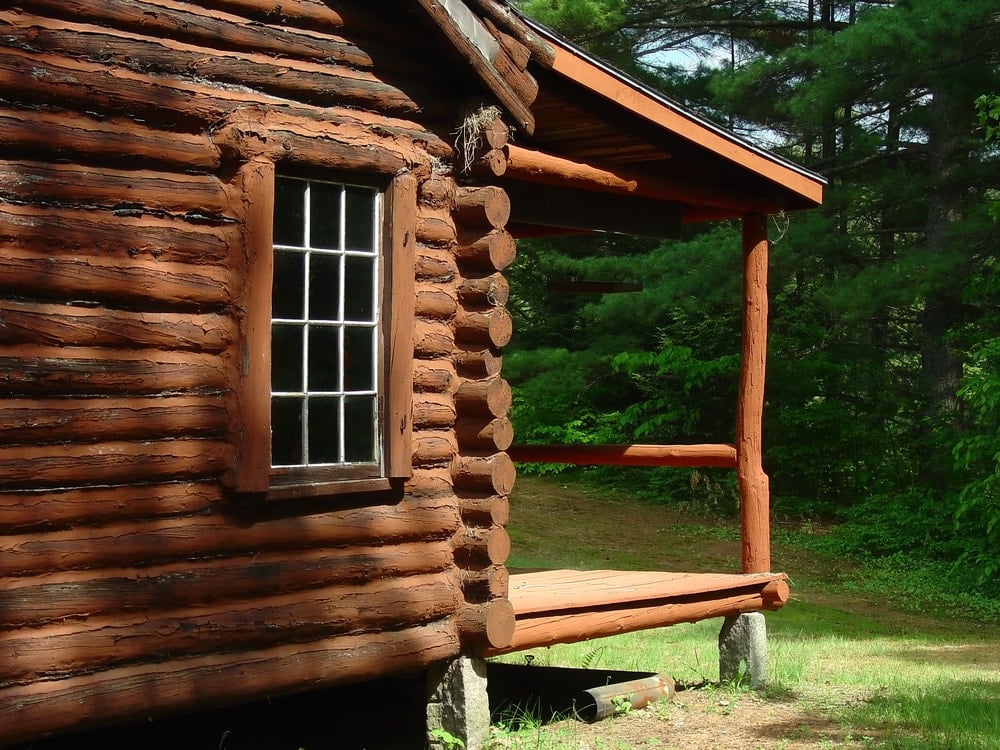
When preparing for severe weather on a camping trip, one of the best steps you can take to ensure that you’re safe is to make sure that you have alternatives for shelter wherever you go; if you’re car camping, this problem is already solved for you.
But if you’re going into the backcountry or any other wilderness area where you won’t have immediate access to your car, research the site ahead of time to get a better sense of what, if any, infrastructure or services are available. Is there a developed ranger station or a visitor’s center if the weather goes bad?
If you’re camping in a state park or a national park, are there cabins available nearby as an alternative to tent camping if the need arises? By taking the time to do some research about where you’re going, you’ll have the tools and the knowledge you need to keep yourself and everyone else in your party safe and happy.
3. Put All Your Guy Lines to Work
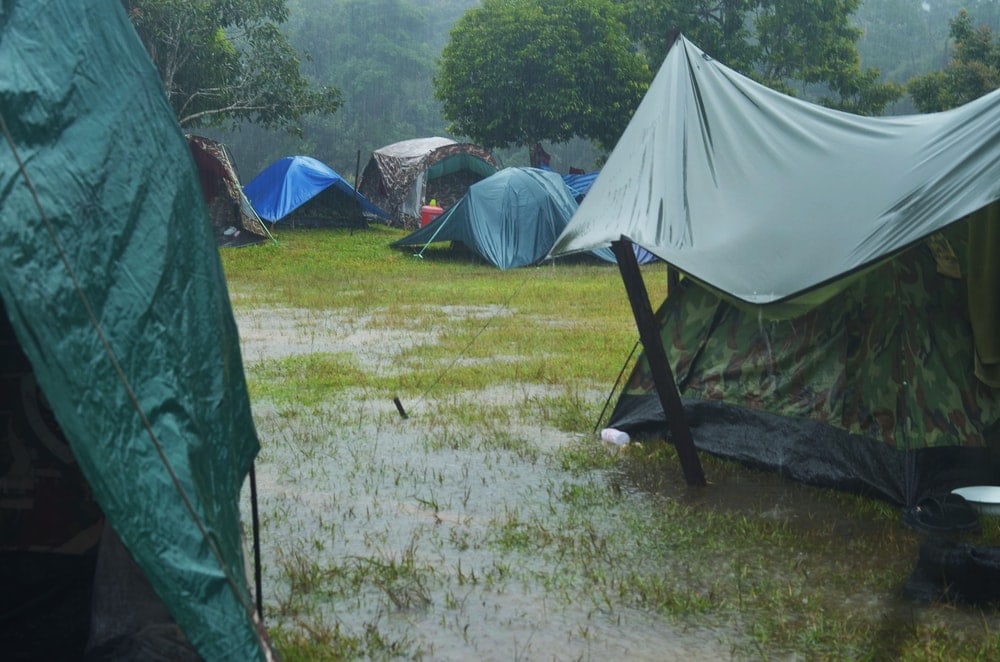
For all the more experienced campers out there, this is probably something you’ve let slip now and again. If you want to stay safe camping in a thunderstorm, use every single guy line that comes with your tent. When you’re setting your guy lines out, you want to ensure that your rain fly is taut and not in contact with the inner wall of your tent.
With tight guy lines and a taut rain tarp, you’ll help minimize the difference between the temperatures inside and outside of your tent. This prevents condensation and helps ventilate your tent.
Suppose you set up all your guidelines correctly. In that case, you can ensure a dry and breathable tent even in the nastiest conditions, where the water automatically flows away from your tent rather than seeping through the tent wall, or worse, pooling around or underneath your tent.
4. Use a Tarp for Extra Protection

There’s almost nothing you can’t do with a plastic tarp. If you’ve ended up with a challenging campsite or you’re looking for quick, easy ways to add a little extra protection from the elements to your campsite, then a sturdy camping tarp can help you out a lot. When it comes to camping in the rain, you’ll be surprised at how quickly the water can find its way in.
If you’re concerned about moisture getting in through the bottom of your tent, placing a tarp between the ground and your tent is a surefire way to help keep your tent nice and dry. If you do use a tarp under your tent, make sure it matches the dimensions of your tent. Using a tarp that’s wider than the base of your tent allows water to pool underneath it.
Another handy use for a tarp if you’re looking for extra protection from the elements while camping in a thunderstorm is to stake the entire tarp above your tent; you can do this using tree limbs or other natural features in the environment. Failing that, another option is to invest in a set of tent poles.
5. Invest in a NOAA Weather Radio
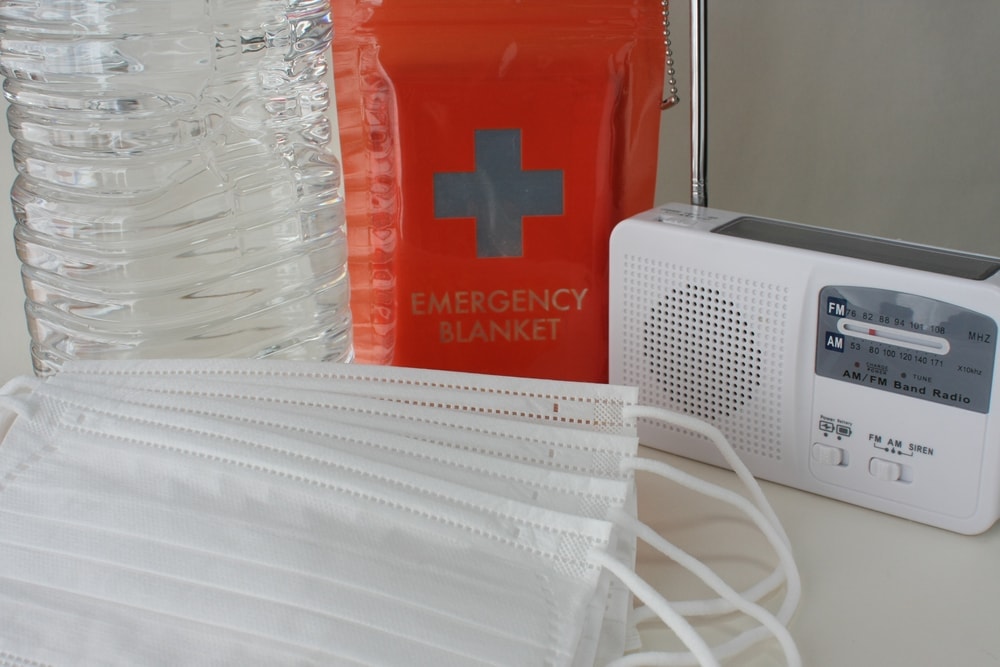
If you’re venturing into a truly isolated area and you want to prepare for severe weather, there’s no better investment than a NOAA weather radio. A NOAA (National Oceanic and Atmospheric Administration) weather radio is battery-powered, and it will sound an alarm if there’s a severe weather alert in your area. This is especially helpful if the weather turns bad while you’re asleep.
NOAA weather radios are popular in certain parts of the country that still lack telephone lines or internet access, and they’re a good option for keeping you informed and safe while you’re on the trail.
6. Put Extra Layers Between Yourself and the Ground
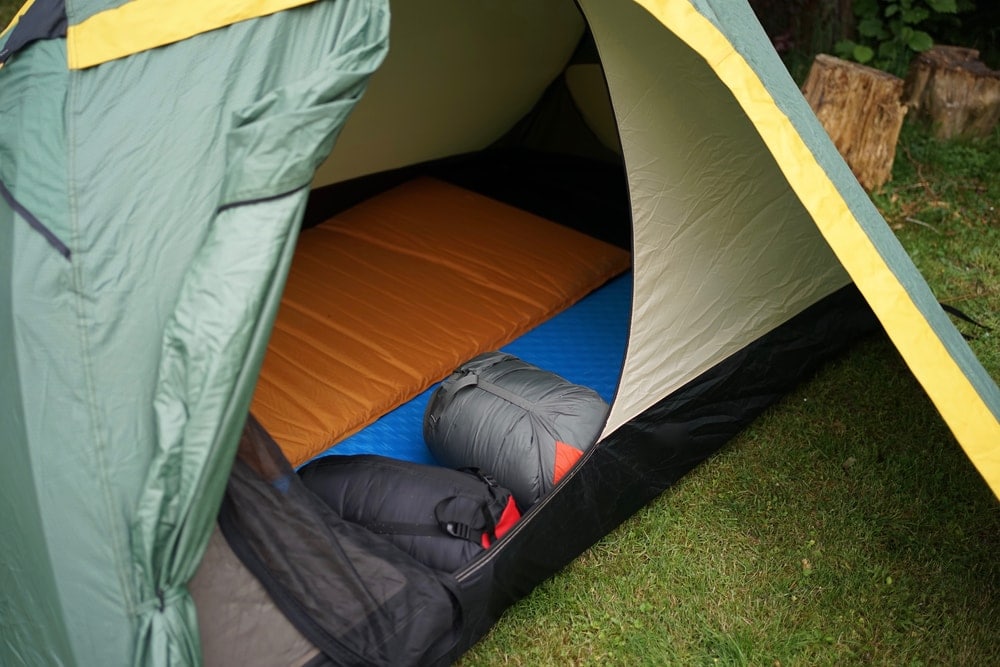
As we stated earlier in this article, deaths from direct lightning strikes are rare; what’s much more common are fatalities or injuries from ground strikes that disperse their impact across the ground you’re on, causing burns, shocks, and other injuries. Maybe you’ve put a tarp under your tent, now consider spreading another one out on the floor of your tent.
By putting a few extra layers between you and the ground, you’re giving yourself additional protection from lightning. It doesn’t have to be a tarp either; even a small folding camp stool or a sleeping pad can do the job.
Like we said earlier, if you’re stuck in your camping in a thunderstorm with no other options, make yourself as small as possible and put as many layers between your body and the ground as possible.
7. Invest in a Solar Charging System
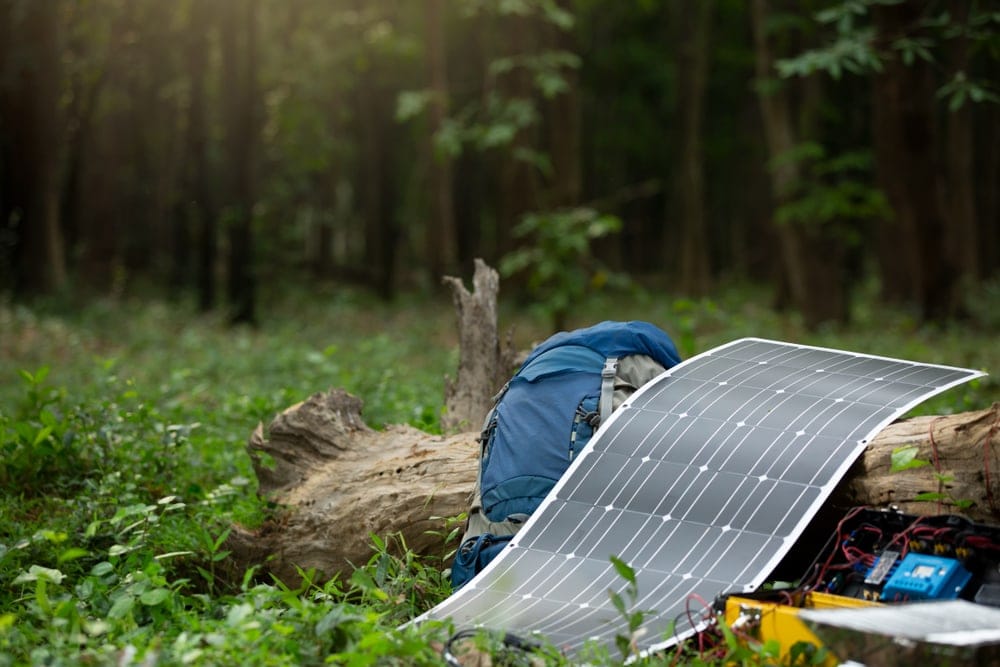
Another way to maintain situational awareness when you’re camping is to consider investing in a solar charging system for your gadgets. By keeping your devices fully charged, you’ll have access to downloaded maps and other information you can use to stay safe in any situation.
- 2500 mAh dual USB port
- 4 foldable solar panels
- Built-in bright LED light with 3 modes
If you’re traveling to an area where there’s cell reception, you can keep your gadgets charged, stay on top of weather alerts, and access weather reports. These solar charging systems have come a long way in the last few years, and now, they’re a feasible and relatively inexpensive option for keeping your campsite connected to civilization if you want to.
If you’re going into the backcountry and you’re looking for a way to add a few more modern conveniences to your trip, larger solar charging systems can even power generators and camp stoves.
If you don’t quite need a solar panel to keep your gadgets charged, a more straightforward option is a handy portable battery. You’ll have to recharge the portable battery at some point, but if you go into the backcountry with a full charge, many of these portable batteries will keep your gadgets charged for hours or days.
8. Large Groups Should Spread Out
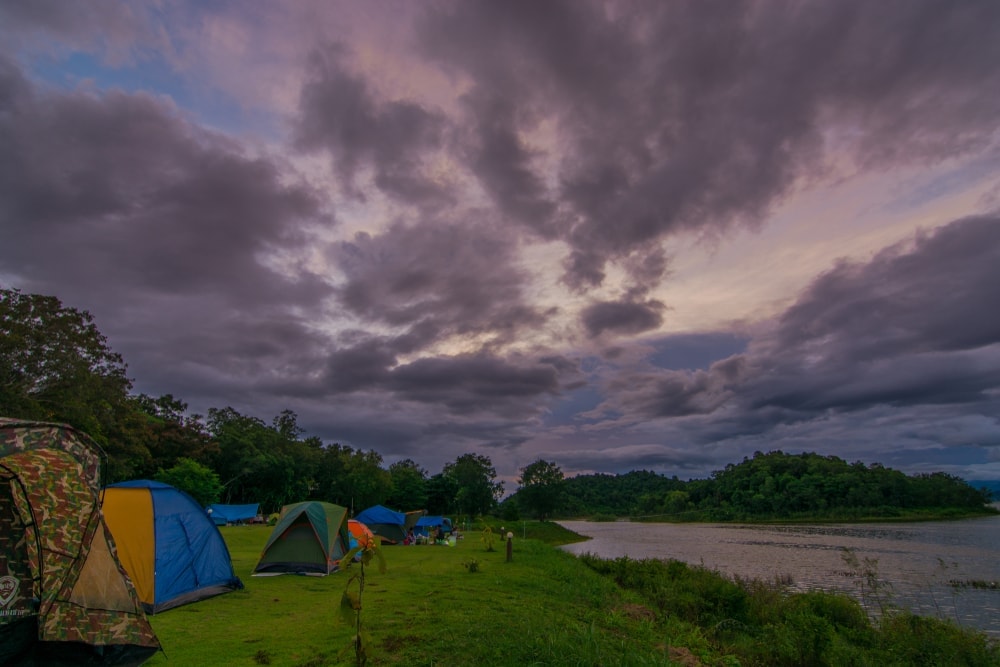
Suppose you’re camping as part of a group and there’s severe weather moving toward your campsite. In that case, you’ll want to think about minimizing the chances of serious injury for everyone in your party. When you’re traveling as a group, all the same rules we’ve been discussing in this article still apply, pick a level campsite where you won’t be in danger from flooding or falling objects.
But if you’re camping as a group, you’ll want to take the extra step of making sure that the members of your group are a little more widely dispersed. Not only does this minimize the chance of severe injuries in the event of hail or a lightning strike, but it also ensures that members of your party won’t be hit by flying debris from other people’s tents.
If you’re camping as a group, make sure everyone in your group knows what to do in the event of a thunderstorm or other severe weather. In case of injury or severe damage to your campsite, make sure that your group has a plan in place to deal with this kind of emergency. This could mean having a first aid kit handy or knowing where the nearest town is.
9. Leave Your Tent During Severe Weather

We know this sounds a little counterintuitive, but your tent is no protection during a thunderstorm, as we’ve said repeatedly. In many ways, it’s the worst place you can be because it turns out those sturdy aluminum tent poles are also great conductors. If you’re camping in a thunderstorm, and it’s realistically safe to do so, leave your tent.
If possible, leave the area and take shelter in a developed building with water and electricity. If no such building is nearby, take shelter in your car. If your car is not an option, get off any high ridges or exposed high ground immediately. Try and find an area that won’t flood.
Make sure you’re dressed in situationally appropriate waterproof gear and avoid standing next to tall trees or objects. Make yourself as small as possible, and again, put layers between you and the ground. If you end up leaving your tent due to severe weather, this is another situation where a tarp can save your life.
10. If You Have to Stay in Your Tent, Make Yourself as Small as Possible

If the weather’s turned nasty and you don’t feel safe leaving your tent, then there are a few things to keep in mind if you’ve decided to use your tent to ride things out. First of all, make yourself as small as possible; this means curling your knees into your chest and then wrapping your arms around them.
If possible, use a camping stool, a sleeping bag, a tarp, or a sleeping pad to put as many layers between your body and the ground as possible. Don’t touch your tent poles, especially if they’re aluminum or a different metal, because this means they’ll be a great conductor for lightning.
Finally, if you’re waiting out a thunderstorm in your tent, don’t touch any metal objects; this includes not only the tent poles and your gear but also zippers and around the tent fly and any built-in pouches or compartments.
You may also like: A Spectrum Of Electrons: What Color Is Lightning?
Camping in a Thunderstorm FAQ
If you have any last-minute questions, we’ve put together this FAQ list to wrap things up.
Can You Stay In A Tent During A Thunderstorm?
If you’re camping in a thunderstorm and you feel reasonably safe because you’re not in an exposed area, you can stay in a tent during a thunderstorm, as long as you understand the tent isn’t going to provide you with any real protection from a lightning strike. See item number ten on our list for further safety tips if you decide to ride things out in your tent.
Do Tents Attract Lightning?
No, tents do not attract lightning on their own. Tents get hit by lightning when you place them so that they become tall, isolated objects compared to the surrounding area. If you set up your tent in an open field or an exposed area such as the area above the timberline, the tent does have a much higher chance of being struck by lightning.
Can You Get Struck by Lightning in a Tent?
Yes, you can; a tent does not protect from lightning during a thunderstorm. Even if lightning strikes the ground nearby or another object or natural formation near your tent, such as a tree, you can still be injured or even killed by the electrical current as it moves across or through nearby surfaces.
What Are the Worst Places to Be During a Thunderstorm?
The worst place to be during a thunderstorm is outside. The worst places to be in a thunderstorm if you’re tent camping in a thunderstorm are landscapes that leave you exposed to the elements or areas where you or your tent are the tallest objects in the immediate area.
You also don’t want to be in any enclosed or low-lying area that might be prone to flooding. Avoid isolated tall trees, areas at or near the timberline, bodies of water, or exposed geographical regions such as cliff faces or exposed ridgelines.
Is There Lightning Protection for Tents Out There?
No, there is no product or method out there that will truly protect tents from lightning. There is also no such thing as a lightning-proof tent.
Does Water Attract Lightning?
Contrary to popular belief, water does not attract lightning. Water acts as an excellent conductor for electricity, which is why the combination of water and electricity is so dangerous to humans.









